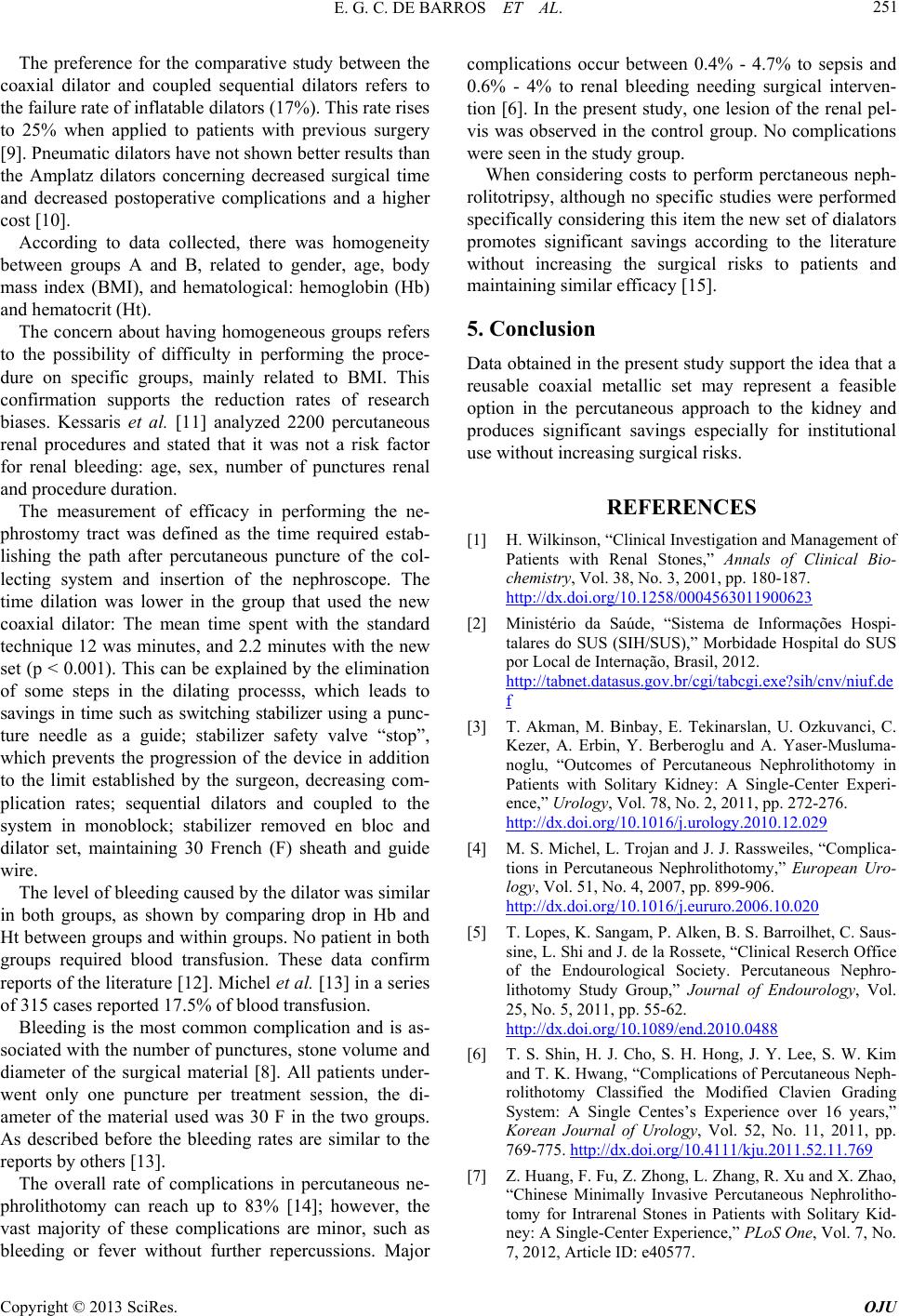
E. G. C. DE BARROS ET AL. 251
The preference for the comparative study between the
coaxial dilator and coupled sequential dilators refers to
the failure rate of inflatable dilators (17%). This rate rises
to 25% when applied to patients with previous surgery
[9]. Pneumatic dilators have not shown better results than
the Amplatz dilators concerning decreased surgical time
and decreased postoperative complications and a higher
cost [10].
According to data collected, there was homogeneity
between groups A and B, related to gender, age, body
mass index (BMI), and hematological: hemoglobin (Hb)
and hematocrit (Ht).
The concern about having homogeneous groups refers
to the possibility of difficulty in performing the proce-
dure on specific groups, mainly related to BMI. This
confirmation supports the reduction rates of research
biases. Kessaris et al. [11] analyzed 2200 percutaneous
renal procedures and stated that it was not a risk factor
for renal bleeding: age, sex, number of punctures renal
and procedure duration.
The measurement of efficacy in performing the ne-
phrostomy tract was defined as the time required estab-
lishing the path after percutaneous puncture of the col-
lecting system and insertion of the nephroscope. The
time dilation was lower in the group that used the new
coaxial dilator: The mean time spent with the standard
technique 12 was minutes, and 2.2 minutes with the new
set (p < 0.001). This can be explained by the elimination
of some steps in the dilating processs, which leads to
savings in time such as switching stabilizer using a punc-
ture needle as a guide; stabilizer safety valve “stop”,
which prevents the progression of the device in addition
to the limit established by the surgeon, decreasing com-
plication rates; sequential dilators and coupled to the
system in monoblock; stabilizer removed en bloc and
dilator set, maintaining 30 French (F) sheath and guide
wire.
The level of bleeding caused by the dilato r was similar
in both groups, as shown by comparing drop in Hb and
Ht between groups and within groups. No patient in both
groups required blood transfusion. These data confirm
reports of the literature [12]. Michel et al. [13] in a series
of 315 cases reported 17.5% of bloo d transfusion.
Bleeding is the most common complication and is as-
sociated with the number of punctures, stone volume and
diameter of the surgical material [8]. All patients under-
went only one puncture per treatment session, the di-
ameter of the material used was 30 F in the two groups.
As described before the bleeding rates are similar to the
reports by others [13].
The overall rate of complications in percutaneous ne-
phrolithotomy can reach up to 83% [14]; however, the
vast majority of these complications are minor, such as
bleeding or fever without further repercussions. Major
complications occur between 0.4% - 4.7% to sepsis and
0.6% - 4% to renal bleeding needing surgical interven-
tion [6]. In the present study, one lesion of the renal pel-
vis was observed in the control group. No complications
were seen in the study group.
When considering costs to perform perctaneous neph-
rolitotripsy, although no specific studies were performed
specifically considering this item the new set of dialato rs
promotes significant savings according to the literature
without increasing the surgical risks to patients and
maintaining similar efficacy [15].
5. Conclusion
Data obtained in the present stu dy support the idea that a
reusable coaxial metallic set may represent a feasible
option in the percutaneous approach to the kidney and
produces significant savings especially for institutional
use without increasing surgical risks.
REFERENCES
[1] H. Wilkinson, “Clinical Investigation and Management of
Patients with Renal Stones,” Annals of Clinical Bio-
chemistry, Vol. 38, No. 3, 2001, pp. 180-187.
http://dx.doi.org/10.1258/0004563011900623
[2] Ministério da Saúde, “Sistema de Informações Hospi-
talares do SUS (SIH/SUS),” Morbidade Hospital do SUS
por Local de Internação, Brasil, 2012.
http://tabnet.datasus.gov.br/cgi/tabcgi.exe?sih/cnv/niuf.de
f
[3] T. Akman, M. Binbay, E. Tekinarslan, U. Ozkuvanci, C.
Kezer, A. Erbin, Y. Berberoglu and A. Yaser-Musluma-
noglu, “Outcomes of Percutaneous Nephrolithotomy in
Patients with Solitary Kidney: A Single-Center Experi-
ence,” Urology, Vol. 78, No. 2, 2011, pp. 272-276.
http://dx.doi.org/10.1016/j.urology.2010.12.029
[4] M. S. Michel, L. Trojan and J. J. Rassweile s, “Complica-
tions in Percutaneous Nephrolithotomy,” European Uro-
logy, Vol. 51, No. 4, 2007, pp. 899-906.
http://dx.doi.org/10.1016/j.eururo.2006.10.020
[5] T. Lopes, K. Sangam, P. Alken, B. S. Barroilhet, C. Saus-
sine, L. Shi and J. de la Rossete, “Clinical Reserch Office
of the Endourological Society. Percutaneous Nephro-
lithotomy Study Group,” Journal of Endourology, Vol.
25, No. 5, 2011, pp. 55-62.
http://dx.doi.org/10.1089/end.2010.0488
[6] T. S. Shin, H. J. Cho, S. H. Hong, J. Y. Lee, S. W. Kim
and T. K. Hwang, “Complications of Percutaneous Neph-
rolithotomy Classified the Modified Clavien Grading
System: A Single Centes’s Experience over 16 years,”
Korean Journal of Urology, Vol. 52, No. 11, 2011, pp.
769-775. http://dx.doi.org/10.4111/kju.2011.52.11.769
[7] Z. Huang, F. Fu, Z. Zhong, L. Zhang, R. Xu and X. Zhao,
“Chinese Minimally Invasive Percutaneous Nephrolitho-
tomy for Intrarenal Stones in Patients with Solitary Kid-
ney: A Single-Center Experience,” PLoS One, Vol. 7, No.
7, 2012, Article ID: e40577.
Copyright © 2013 SciRes. OJU